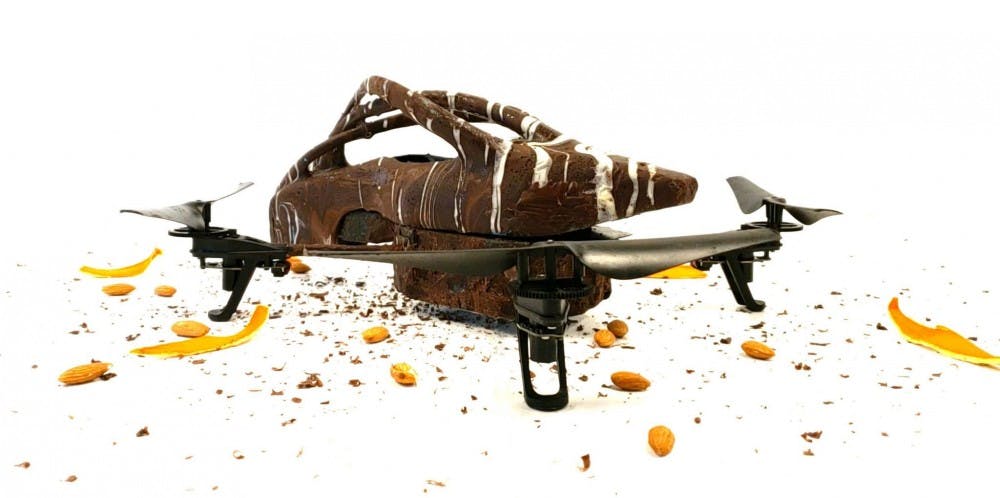Some people may find joy in eating chocolate and others may enjoy flying drones—three Duke students combined these hobbies to build a chocolate drone.
Juniors Anuj Thakkar, Carlo Lindner and Ben Succop decided to use their free time to apply their engineering skills and built a drone made out of chocolate.
Succop explained that Duke students often get caught up in the monotony of classes and careers, so that their creativity may easily be stifled. He emphasized the importance of working on projects just for the sake of making cool things.
“In the margins of our schedule are where opportunities for the coolest experiences with the coolest people reside, whether it’s something fun and silly like our chocolate drone, or something truly world-changing,” Succop wrote in an email.
The idea of an edible drone initially came up a year ago while Thakkar was having coffee with a friend. Whenever he had time, he said he would make it happen. Thakkar mentioned the idea in passing to his friends Lindner and Succop.
“Knowing Anuj is the kind of guy that relentlessly pursues an idea, no matter how far-fetched it seems, until it’s accomplished, I didn’t even question him,” Succop wrote.
While the three students were at Duke over the summer, they became more and more motivated to start prototyping an edible drone. They attempted with three other foods before deciding on chocolate. They explained that cheese was too ugly and oily, jell-o was too heavy and bread was too difficult to mold. However, chocolate was moldable, light and appealing.
The team initially tried to construct the drone using a 3D-printed negative mold, which involves pouring melted chocolate into the mold, Lindner said. However, they ran into issues when trying to remove the plastic mold because the chocolate kept breaking.
Instead, the team used a positive 3D-printed mold, where they poured the chocolate around the mold and let it solidify. They then removed the plastic, leaving a chocolate shell. Lindner explained that they modified a drone by removing as much of the shell as they could and replacing it with chocolate, while leaving the electronics.
Lindner said they got a good product after just three attempts, and they shot a demo video of their first working chocolate drone on their cell phones.
“We thought, 'our demo videos looked so nice, let’s pursue something bigger than us just tinkering around with chocolate,'” Lindner said.
An idea from Thakkar’s initial conversation about the edible drone was working with chocolate companies for promotional campaigns. Although commercialization of the product would be possible, Thakkar noted that there would be many hurdles to go through in terms of regulations.
The team sent out emails to different chocolate companies with the video of their drone, and Chocolove enthusiastically responded and wanted to collaborate. Chocolove sent the team many boxes of dark chocolate to use, and Succop noted that they still have dozens of leftover chocolate bars from the hundreds that they sent them.
However, Thakkar said one of the biggest challenges they faced was switching from Harris Teeter brand chocolate to Chocolove’s chocolate, which was more brittle but more tasty.
“We were trying to balance the weight limitations of the drone to keep it structurally sound with a very brittle material,” Thakkar said. “That was one of the biggest hurdles, balancing the constraints and the objectives.”
Succop also noted the difficulty in adjusting the weight of the drone with structural integrity. They tried making a thicker shell to increase impact strength, but the power of the drone could not support the weight. Instead, the team took inspiration from fiber composites by integrating sweet vermicelli, a long pasta, into the chocolate to keep it light and strong.
Lindner predicted that the team likely made 20 to 30 drones. They worked on improving the design by shaving off weight, and they also tinkered with many different shapes and garnishes to improve the drone’s aesthetic.
“This has made me think about my engineering projects in a more liberating way,” Lindner said. “Before this, I was hesitant to take on something that didn’t have immediate potential or something I couldn’t pursue long-term. It started off as something so silly and seemingly pointless, but it was really fun and we learned a lot.”
In early September, Thakkar surprised one of his friends for her birthday by flying a chocolate drone to her door at the Smart Home, where she broke off a piece and ate some of it. Thakkar said part of Chocolove’s message is “share it with someone you love.”
People’s reactions to their drone at the Smart Home were particularly memorable to Succop. There were those in awe of the project and those who questioned what was wrong with them, he joked.
Get The Chronicle straight to your inbox
Sign up for our weekly newsletter. Cancel at any time.
Everyone on the team brought their own expertise, but the project was fluid and highly collaborative between the three of them. They all designed drone shells and created the chocolate molds together.
In the future, Lindner talked about possibly designing a chocolate 3D printer, and Succop wants to try making the cheese drone, which he imagines being used as a flying cheeseboard at fancy gatherings.
“I think it’s important to work on fun projects that people consider stupid or not applicable because it helps discovers things that nobody would have, had you not pursued that dumb, crazy idea,” Thakkar said. “It challenges you to think about technology in different ways, it’s good to do what is not expected.”

